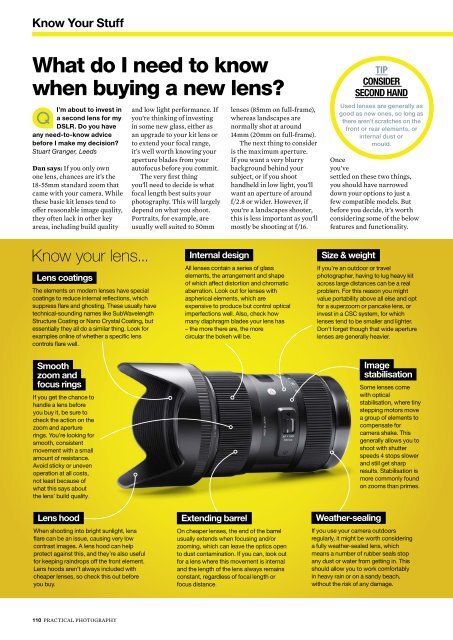Practical Photography - May issue
Create successful ePaper yourself
Turn your PDF publications into a flip-book with our unique Google optimized e-Paper software.
Know Your Stuff<br />
What do I need to know<br />
when buying a new lens?<br />
I’m about to invest in<br />
a second lens for my<br />
DSLR. Do you have<br />
any need-to-know advice<br />
before I make my decision?<br />
Stuart Granger, Leeds<br />
Dan says: If you only own<br />
one lens, chances are it’s the<br />
18-55mm standard zoom that<br />
came with your camera. While<br />
these basic kit lenses tend to<br />
offer reasonable image quality,<br />
they often lack in other key<br />
areas, including build quality<br />
and low light performance. If<br />
you’re thinking of investing<br />
in some new glass, either as<br />
an upgrade to your kit lens or<br />
to extend your focal range,<br />
it’s well worth knowing your<br />
aperture blades from your<br />
autofocus before you commit.<br />
The very first thing<br />
you’ll need to decide is what<br />
focal length best suits your<br />
photography. This will largely<br />
depend on what you shoot.<br />
Portraits, for example, are<br />
usually well suited to 50mm<br />
lenses (85mm on full-frame),<br />
whereas landscapes are<br />
normally shot at around<br />
14mm (20mm on full-frame).<br />
The next thing to consider<br />
is the maximum aperture.<br />
If you want a very blurry<br />
background behind your<br />
subject, or if you shoot<br />
handheld in low light, you’ll<br />
want an aperture of around<br />
f/2.8 or wider. However, if<br />
you’re a landscapes shooter,<br />
this is less important as you’ll<br />
mostly be shooting at f/16.<br />
TIP<br />
CONSIDER<br />
SECOND HAND<br />
Used lenses are generally as<br />
good as new ones, so long as<br />
there aren’t scratches on the<br />
front or rear elements, or<br />
internal dust or<br />
mould.<br />
Once<br />
you’ve<br />
settled on these two things,<br />
you should have narrowed<br />
down your options to just a<br />
few compatible models. But<br />
before you decide, it’s worth<br />
considering some of the below<br />
features and functionality.<br />
Know your lens...<br />
Lens coatings<br />
The elements on modern lenses have special<br />
coatings to reduce internal reflections, which<br />
suppress flare and ghosting. These usually have<br />
technical-sounding names like SubWavelength<br />
Structure Coating or Nano Crystal Coating, but<br />
essentially they all do a similar thing. Look for<br />
examples online of whether a specific lens<br />
controls flare well.<br />
Smooth<br />
zoom and<br />
focus rings<br />
If you get the chance to<br />
handle a lens before<br />
you buy it, be sure to<br />
check the action on the<br />
zoom and aperture<br />
rings. You’re looking for<br />
smooth, consistent<br />
movement with a small<br />
amount of resistance.<br />
Avoid sticky or uneven<br />
operation at all costs,<br />
not least because of<br />
what this says about<br />
the lens’ build quality.<br />
Lens hood<br />
When shooting into bright sunlight, lens<br />
flare can be an <strong>issue</strong>, causing very low<br />
contrast images. A lens hood can help<br />
protect against this, and they’re also useful<br />
for keeping raindrops off the front element.<br />
Lens hoods aren’t always included with<br />
cheaper lenses, so check this out before<br />
you buy.<br />
Internal design<br />
All lenses contain a series of glass<br />
elements, the arrangement and shape<br />
of which affect distortion and chromatic<br />
aberration. Look out for lenses with<br />
aspherical elements, which are<br />
expensive to produce but control optical<br />
imperfections well. Also, check how<br />
many diaphragm blades your lens has<br />
– the more there are, the more<br />
circular the bokeh will be.<br />
Extending barrel<br />
On cheaper lenses, the end of the barrel<br />
usually extends when focusing and/or<br />
zooming, which can leave the optics open<br />
to dust contamination. If you can, look out<br />
for a lens where this movement is internal<br />
and the length of the lens always remains<br />
constant, regardless of focal length or<br />
focus distance.<br />
Size & weight<br />
If you’re an outdoor or travel<br />
photographer, having to lug heavy kit<br />
across large distances can be a real<br />
problem. For this reason you might<br />
value portability above all else and opt<br />
for a superzoom or pancake lens, or<br />
invest in a CSC system, for which<br />
lenses tend to be smaller and lighter.<br />
Don’t forget though that wide aperture<br />
lenses are generally heavier.<br />
Weather-sealing<br />
Image<br />
stabilisation<br />
Some lenses come<br />
with optical<br />
stabilisation, where tiny<br />
stepping motors move<br />
a group of elements to<br />
compensate for<br />
camera shake. This<br />
generally allows you to<br />
shoot with shutter<br />
speeds 4 stops slower<br />
and still get sharp<br />
results. Stabilisation is<br />
more commonly found<br />
on zooms than primes.<br />
If you use your camera outdoors<br />
regularly, it might be worth considering<br />
a fully weather-sealed lens, which<br />
means a number of rubber seals stop<br />
any dust or water from getting in. This<br />
should allow you to work comfortably<br />
in heavy rain or on a sandy beach,<br />
without the risk of any damage.<br />
110 PRACTICAL PHOTOGRAPHY

















